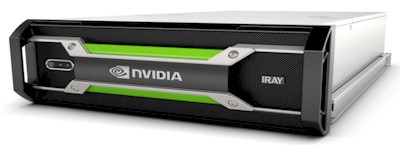Product Design Streamlined By Nvidia Iray VCA

While the forthcoming “Pascal” GPUs stole most of the show at the GPU Technology Conference in San Jose this week, these GPUs won’t be here until 2016. But motorheads who like iron did not walk out of the conference empty handed. Nvidia is actually shipping an updated version of its Visual Computing Appliance (VCA) equipped with a software stack that allows for product design and rendering to be implemented in real-time on a single device.
Or, as the case may be for larger designs and renderings, a cluster of such devices, which are known as the Iray VCAs.
In his keynote address this week, Nvidia co-founder and CEO Jen-Hsun Huang said that a rack of 19 of these appliances would pack over 1 petaflops of double-precision floating point performance, which is as much raw computing as a capability-class supercomputing system costing $500 million would have run only a few years ago. Huang said further that a since Iray VCA appliance, with a manufacturer’s suggested retail price of $50,000 and packed with eight GRID-capable GPU cards in them, would pack about as much punch as a cluster of workstations using a bunch of the company’s Quadro K5000 graphics cards that costs on the order of $300,000.
The Iray VCA is an upgraded version of the original GRID VCA, which was announced by Nvidia last year and which marked the company’s entry into the systems business. The original GRID VCA had four of the “Kepler” GRID cards, each with 4 GB of GDDR5 frame buffer memory and two GPUs, plus a single Xeon E5-2600 v1 processor with eight cores and sixteen threads equipped with 192 GB of main memory. This machine cost $24,900, plus another $2,400 for the Nvidia GRID software stack for virtualizing workstation instances. Loaded up with eight dual-GPU GRID cards, another eight-core Xeon E5 processor, and 384 GB of main memory for the CPU, the GRID VCA cost $39,900. This maximum setup was able to support up to sixteen virtual workstations at the same time.
 The Iray VCA announced this week has two of Intel’s latest ten-core Xeon E5-2600 v2 processors and 256 GB of main memory to feed them. The machine has eight more powerful Kepler GRID GPUs, each with 12 GB of GDDR5 frame buffer memory and sporting a total of 23,040 CUDA cores for doing the heavy lifting for product design and rendering. The system has a 2 TB solid state disk and comes with two 10 Gb/sec Ethernet ports and one InfiniBand port (presumably running at least at a 40 Gb/sec speed). The machine comes equipped with the CentOS variant of Red Hat Enterprise Linux as well as Nvidia’s Iray ray tracing and rendering libraries and the Iray VCA Cluster Manager for linking multiple units together to share the design and rendering workloads.
The Iray VCA announced this week has two of Intel’s latest ten-core Xeon E5-2600 v2 processors and 256 GB of main memory to feed them. The machine has eight more powerful Kepler GRID GPUs, each with 12 GB of GDDR5 frame buffer memory and sporting a total of 23,040 CUDA cores for doing the heavy lifting for product design and rendering. The system has a 2 TB solid state disk and comes with two 10 Gb/sec Ethernet ports and one InfiniBand port (presumably running at least at a 40 Gb/sec speed). The machine comes equipped with the CentOS variant of Red Hat Enterprise Linux as well as Nvidia’s Iray ray tracing and rendering libraries and the Iray VCA Cluster Manager for linking multiple units together to share the design and rendering workloads.
This Iray rendering software provides photorealism – and Nvidia is not kidding about this, you cannot easily tell between a rendered digital object and a picture of a real one, except that you cannot manipulate the picture or do cutaway views of the object in real time. Design tools such as CATIA from Dassault Systemes and 3ds Max from Autodesk support the Iray feature and can therefore run across a cluster of Iray VCAs.
The styling design department at Honda Research and Development, the R&D arm of Japanese car maker Honda Motor Company, has a 25-node cluster of Iray VCA appliances that it is using to refine its future car designs. The photorealism is truly stunning, as Huang showed off during his keynote, not only spinning a Honda Civic around to see how it looked, but also peeling off layers of the vehicle to show the innards of the car, down to electrical wires and floor mats. Now, designers do not have to build a physical mockup after their design to see what it looks like, or create movies of rendered objects. The design is rendered in real-time as the design changes, which eliminates months or years of work.
The Iray VCA will ship this summer through Nvidia’s reseller channel, which includes CADnetwork, Fluidyna, IGI, and Migenius. That $50,000 price tag includes a license to the Iray libraries and the first year of maintenance and updates for the hardware and software stack.
In a separate announcement, VMware and Nvidia said that they had teamed up to get the Nvidia GRID systems on the backend of VMware’s Horizon Desktop-as-a-Service (DaaS), which runs on its vCloud Hybrid Service public cloud. The two are also working to get the on-premises Horizon View desktop virtualization broker certified to run atop GRID systems with virtual GPUs available for desktop slices. The GRID-enabled VMware software is in the labs now, will be in tech preview later this year, and will be generally available in 2015. A half a billion PCs are out there on corporate desktops, and a fair percentage of them could make a move back towards the datacenter if this GRID-Horizon combination works well.










